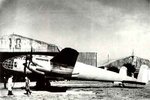...or faster than real ones anyway 
Please toss in you proposals, for a light/medium/heavy bomber that could be conceived between 1939-1942(from proposal to deployment; 1941 as a deadline is fine also, if judged posible), using engines armament (if any?) available for USAAC back then.
Please toss in you proposals, for a light/medium/heavy bomber that could be conceived between 1939-1942(from proposal to deployment; 1941 as a deadline is fine also, if judged posible), using engines armament (if any?) available for USAAC back then.



